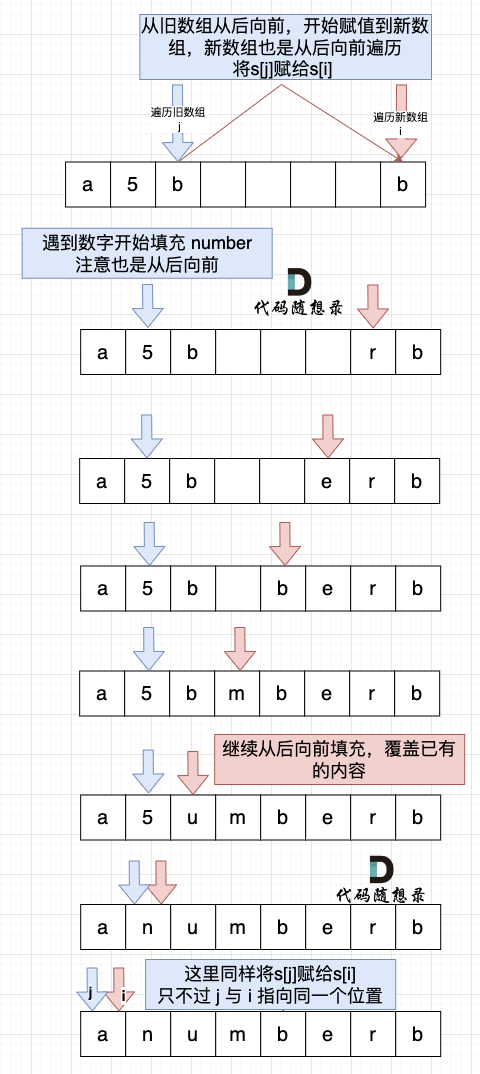给定一个字符串 s,它包含小写字母和数字字符,请编写一个函数,将字符串中的字母字符保持不变,而将每个数字字符替换为number。
例如,对于输入字符串 "a1b2c3",函数应该将其转换为 "anumberbnumbercnumber"。
对于输入字符串 "a5b",函数应该将其转换为 "anumberb"
输入:一个字符串 s,s 仅包含小写字母和数字字符。
输出:打印一个新的字符串,其中每个数字字符都被替换为了number
样例输入:a1b2c3
样例输出:anumberbnumbercnumber
数据范围:1 <= s.length < 10000。
如果想把这道题目做到极致,就不要只用额外的辅助空间了! (不过使用Java刷题的录友,一定要使用辅助空间,因为Java里的string不能修改)
首先扩充数组到每个数字字符替换成 "number" 之后的大小。
例如 字符串 "a5b" 的长度为3,那么 将 数字字符变成字符串 "number" 之后的字符串为 "anumberb" 长度为 8。
如图:
然后从后向前替换数字字符,也就是双指针法,过程如下:i指向新长度的末尾,j指向旧长度的末尾。
有同学问了,为什么要从后向前填充,从前向后填充不行么?
从前向后填充就是O(n^2)的算法了,因为每次添加元素都要将添加元素之后的所有元素整体向后移动。
其实很多数组填充类的问题,其做法都是先预先给数组扩容带填充后的大小,然后在从后向前进行操作。
这么做有两个好处:
- 不用申请新数组。
- 从后向前填充元素,避免了从前向后填充元素时,每次添加元素都要将添加元素之后的所有元素向后移动的问题。
C++代码如下:
#include <iostream>
using namespace std;
int main() {
string s;
while (cin >> s) {
int sOldIndex = s.size() - 1;
int count = 0; // 统计数字的个数
for (int i = 0; i < s.size(); i++) {
if (s[i] >= '0' && s[i] <= '9') {
count++;
}
}
// 扩充字符串s的大小,也就是将每个数字替换成"number"之后的大小
s.resize(s.size() + count * 5);
int sNewIndex = s.size() - 1;
// 从后往前将数字替换为"number"
while (sOldIndex >= 0) {
if (s[sOldIndex] >= '0' && s[sOldIndex] <= '9') {
s[sNewIndex--] = 'r';
s[sNewIndex--] = 'e';
s[sNewIndex--] = 'b';
s[sNewIndex--] = 'm';
s[sNewIndex--] = 'u';
s[sNewIndex--] = 'n';
} else {
s[sNewIndex--] = s[sOldIndex];
}
sOldIndex--;
}
cout << s << endl;
}
}
- 时间复杂度:O(n)
- 空间复杂度:O(1)
此时算上本题,我们已经做了七道双指针相关的题目了分别是:
这里也给大家拓展一下字符串和数组有什么差别,
字符串是若干字符组成的有限序列,也可以理解为是一个字符数组,但是很多语言对字符串做了特殊的规定,接下来我来说一说C/C++中的字符串。
在C语言中,把一个字符串存入一个数组时,也把结束符 '\0'存入数组,并以此作为该字符串是否结束的标志。
例如这段代码:
char a[5] = "asd";
for (int i = 0; a[i] != '\0'; i++) {
}
在C++中,提供一个string类,string类会提供 size接口,可以用来判断string类字符串是否结束,就不用'\0'来判断是否结束。
例如这段代码:
string a = "asd";
for (int i = 0; i < a.size(); i++) {
}
那么vector< char > 和 string 又有什么区别呢?
其实在基本操作上没有区别,但是 string提供更多的字符串处理的相关接口,例如string 重载了+,而vector却没有。
所以想处理字符串,我们还是会定义一个string类型。
解法一
import java.util.Scanner;
public class Main {
public static String replaceNumber(String s) {
int count = 0; // 统计数字的个数
int sOldSize = s.length();
for (int i = 0; i < s.length(); i++) {
if(Character.isDigit(s.charAt(i))){
count++;
}
}
// 扩充字符串s的大小,也就是每个空格替换成"number"之后的大小
char[] newS = new char[s.length() + count * 5];
int sNewSize = newS.length;
// 将旧字符串的内容填入新数组
System.arraycopy(s.toCharArray(), 0, newS, 0, sOldSize);
// 从后先前将空格替换为"number"
for (int i = sNewSize - 1, j = sOldSize - 1; j < i; j--, i--) {
if (!Character.isDigit(newS[j])) {
newS[i] = newS[j];
} else {
newS[i] = 'r';
newS[i - 1] = 'e';
newS[i - 2] = 'b';
newS[i - 3] = 'm';
newS[i - 4] = 'u';
newS[i - 5] = 'n';
i -= 5;
}
}
return new String(newS);
};
public static void main(String[] args) {
Scanner scanner = new Scanner(System.in);
String s = scanner.next();
System.out.println(replaceNumber(s));
scanner.close();
}
}解法二
// 为了还原题目本意,先把原数组复制到扩展长度后的新数组,然后不再使用原数组、原地对新数组进行操作。
import java.util.*;
public class Main {
public static void main(String[] args) {
Scanner sc = new Scanner(System.in);
String s = sc.next();
int len = s.length();
for (int i = 0; i < s.length(); i++) {
if (s.charAt(i) >= 0 && s.charAt(i) <= '9') {
len += 5;
}
}
char[] ret = new char[len];
for (int i = 0; i < s.length(); i++) {
ret[i] = s.charAt(i);
}
for (int i = s.length() - 1, j = len - 1; i >= 0; i--) {
if ('0' <= ret[i] && ret[i] <= '9') {
ret[j--] = 'r';
ret[j--] = 'e';
ret[j--] = 'b';
ret[j--] = 'm';
ret[j--] = 'u';
ret[j--] = 'n';
} else {
ret[j--] = ret[i];
}
}
System.out.println(ret);
}
}package main
import "fmt"
func main(){
var strByte []byte
fmt.Scanln(&strByte)
for i := 0; i < len(strByte); i++{
if strByte[i] <= '9' && strByte[i] >= '0' {
inserElement := []byte{'n','u','m','b','e','r'}
strByte = append(strByte[:i], append(inserElement, strByte[i+1:]...)...)
i = i + len(inserElement) -1
}
}
fmt.Printf(string(strByte))
}Go使用双指针解法
package main
import "fmt"
func replaceNumber(strByte []byte) string {
// 查看有多少字符
numCount, oldSize := 0, len(strByte)
for i := 0; i < len(strByte); i++ {
if (strByte[i] <= '9') && (strByte[i] >= '0') {
numCount ++
}
}
// 增加长度
for i := 0; i < numCount; i++ {
strByte = append(strByte, []byte(" ")...)
}
tmpBytes := []byte("number")
// 双指针从后遍历
leftP, rightP := oldSize-1, len(strByte)-1
for leftP < rightP {
rightShift := 1
// 如果是数字则加入number
if (strByte[leftP] <= '9') && (strByte[leftP] >= '0') {
for i, tmpByte := range tmpBytes {
strByte[rightP-len(tmpBytes)+i+1] = tmpByte
}
rightShift = len(tmpBytes)
} else {
strByte[rightP] = strByte[leftP]
}
// 更新指针
rightP -= rightShift
leftP -= 1
}
return string(strByte)
}
func main(){
var strByte []byte
fmt.Scanln(&strByte)
newString := replaceNumber(strByte)
fmt.Println(newString)
}const readline = require("readline");
const rl = readline.createInterface({
input: process.stdin,
output: process.stdout
})
function main() {
const num0 = "0".charCodeAt();
const num9 = "9".charCodeAt();
const a = "a".charCodeAt();
const z = "z".charCodeAt();
function isAZ(str) {
return str >= a && str <= z;
}
function isNumber(str) {
return str >= num0 && str <= num9;
}
rl.on("line", (input) => {
let n = 0;
for (let i = 0; i < input.length; i++) {
const val = input[i].charCodeAt();
if (isNumber(val)) {
n+= 6;
}
if (isAZ(val)) {
n++;
}
}
const ans = new Array(n).fill(0);
let index = input.length - 1;
for (let i = n - 1; i >= 0; i--) {
const val = input[index].charCodeAt();
if (isAZ(val)) {
ans[i] = input[index];
}
if (isNumber(val)) {
ans[i] = "r";
ans[i - 1] = "e";
ans[i - 2] = "b";
ans[i - 3] = "m";
ans[i - 4] = "u";
ans[i - 5] = "n";
i -= 5;
}
index--;
}
console.log(ans.join(""));
})
}
main();<?php
// 标准输入
$s = trim(fgets(STDIN));
$oldLen = strlen($s);
$count = 0;
for ($i = 0; $i < $oldLen; $i++) {
if (is_numeric($s[$i])) {
$count++;
}
}
// 扩充字符串
$s = str_pad($s, $oldLen + $count * 5);
$newLen = strlen($s);
while($oldLen >= 0) {
if (is_numeric($s[$oldLen])) {
$s[$newLen--] = 'r';
$s[$newLen--] = 'e';
$s[$newLen--] = 'b';
$s[$newLen--] = 'm';
$s[$newLen--] = 'u';
$s[$newLen--] = 'n';
} else {
$s[$newLen--] = $s[$oldLen];
}
$oldLen--;
}
echo $s;
?>
